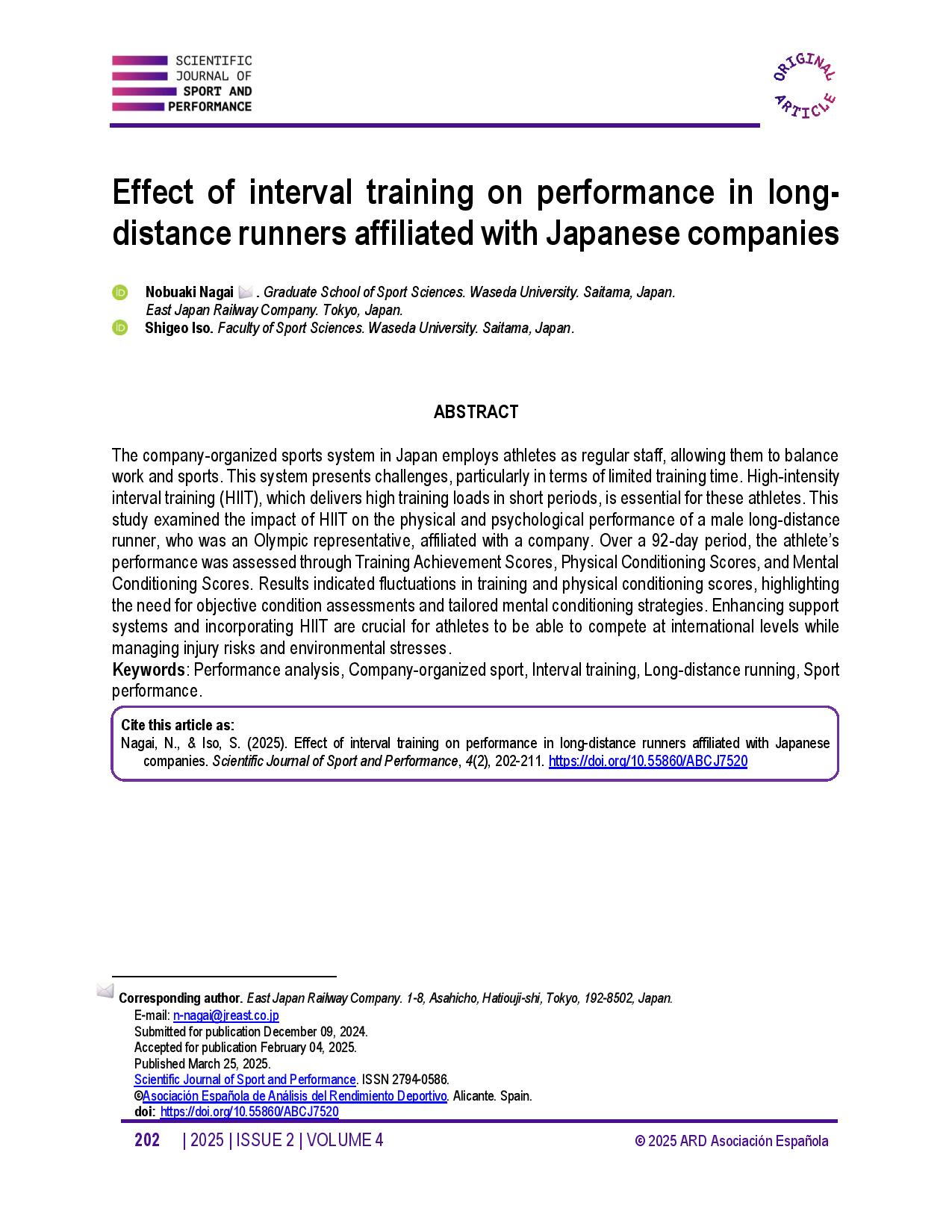Effect of interval training on performance in long-distance runners affiliated with Japanese companies
Main Article Content
Abstract
The company-organized sports system in Japan employs athletes as regular staff, allowing them to balance work and sports. This system presents challenges, particularly in terms of limited training time. High-intensity interval training (HIIT), which delivers high training loads in short periods, is essential for these athletes. This study examined the impact of HIIT on the physical and psychological performance of a male long-distance runner, who was an Olympic representative, affiliated with a company. Over a 92-day period, the athlete’s performance was assessed through Training Achievement Scores, Physical Conditioning Scores, and Mental Conditioning Scores. Results indicated fluctuations in training and physical conditioning scores, highlighting the need for objective condition assessments and tailored mental conditioning strategies. Enhancing support systems and incorporating HIIT are crucial for athletes to be able to compete at international levels while managing injury risks and environmental stresses.
Article Details

This work is licensed under a Creative Commons Attribution-NonCommercial-ShareAlike 4.0 International License.
References
Bakiev, E. (2013). The Influence of Interpersonal Trust and Organizational Commitment on Perceived Organizational Performance. International Journal of Economics and Business Research, 3, 166-180.
Billat, L. V. (2001). Interval training for performance: a scientific and empirical practice: special recommendations for middle-and long-distance running. Part I: aerobic interval training. Sports medicine, 31, 13-31. https://doi.org/10.2165/00007256-200131010-00002 DOI: https://doi.org/10.2165/00007256-200131010-00002
Burgomaster, K. A., Hughes, S. C., Heigenhauser, G. J. F., Bradwell, S. N. & Gibala, M. J. (2005). Six sessions of sprint interval training increases muscle oxidative potential and cycle endurance capacity in humans. Journal of Applied Physiology, 98, 1985-1990. https://doi.org/10.1152/japplphysiol.01095.2004 DOI: https://doi.org/10.1152/japplphysiol.01095.2004
Federations, J. A. O. A. (2023). Retrieved from [Accessed 2025, March 11]: https://www.jaaf.or.jp/jch/107/10000m/
Fletcher, D. & Scott, M. (2010). Psychological stress in sports coaches: a review of concepts, research, and practice. J Sports Sci, 28, 127-37. https://doi.org/10.1080/02640410903406208 DOI: https://doi.org/10.1080/02640410903406208
Fox, E. L., Bartels, R. L., Billings, C. E., O'brien, R., Bason, R. & Mathews, D. K. (1975). Frequency and duration of interval training programs and changes in aerobic power. J Appl Physiol, 38, 481-4. https://doi.org/10.1152/jappl.1975.38.3.481 DOI: https://doi.org/10.1152/jappl.1975.38.3.481
Gibala, M. J., Little, J. P., Van Essen, M., Wilkin, G. P., Burgomaster, K. A., Safdar, A., Raha, S. & Tarnopolsky, M. A. (2006). Short-term sprint interval versus traditional endurance training: similar initial adaptations in human skeletal muscle and exercise performance. J Physiol, 575, 901-11. https://doi.org/10.1113/jphysiol.2006.112094 DOI: https://doi.org/10.1113/jphysiol.2006.112094
Lipman, G. S., Sharp, L. J., Christensen, M., Phillips, C., Ditullio, A., Dalton, A., Ng, P., Shangkuan, J., Shea, K. & Krabak, B. J. (2016). Paper Tape Prevents Foot Blisters: A Randomized Prevention Trial Assessing Paper Tape in Endurance Distances II (Pre-TAPED II). Clin J Sport Med, 26, 362-8. https://doi.org/10.1097/JSM.0000000000000319 DOI: https://doi.org/10.1097/JSM.0000000000000319
Llanos-Lagos, C., Ramirez-Campillo, R., Moran, J. & De Villarreal, E. S. (2024). Effect of Strength Training Programs in Middle- and Long-Distance Runners' Economy at Different Running Speeds: A Systematic Review with Meta-analysis. Sports Medicine, 54, 895-932. https://doi.org/10.1007/s40279-023-01978-y DOI: https://doi.org/10.1007/s40279-023-01978-y
Nicholls, A. R., Polman, R., Levy, A. R., Taylor, J. & Cobley, S. (2007). Stressors, coping, and coping effectiveness: Gender, type of sport, and skill differences. Journal of Sports Sciences, 25, 1521-1530. https://doi.org/10.1080/02640410701230479 DOI: https://doi.org/10.1080/02640410701230479
Nicholls, A. R., Polman, R. C. J., Levy, A. R. & Backhouse, S. H. (2009). Mental toughness in sport: Achievement level, gender, age, experience, and sport type differences. Personality and Individual Differences, 47, 73-75. https://doi.org/10.1016/j.paid.2009.02.006 DOI: https://doi.org/10.1016/j.paid.2009.02.006
Radice, F., Velasquez, A. & Orizola, A. (2017). Triceps surae injuries. Muscle and Tendon Injuries: Evaluation and Management. Springer. https://doi.org/10.1007/978-3-662-54184-5_32 DOI: https://doi.org/10.1007/978-3-662-54184-5_32
Thelwell, R. C., Wagstaff, C. R., Rayner, A., Chapman, M. & Barker, J. (2017). Exploring athletes' perceptions of coach stress in elite sport environments. J Sports Sci, 35, 44-55. https://doi.org/10.1080/02640414.2016.1154979 DOI: https://doi.org/10.1080/02640414.2016.1154979
Van Der Vlegel, M., Polinder, S., Toet, H., Panneman, M. J. M., Geraerds, A. J. L. M. & Haagsma, J. A. (2022). Anxiety, depression and post-traumatic stress symptoms among injury patients and the association with outcome after injury. European Journal of Psychotraumatology, 13. https://doi.org/10.1080/20008198.2021.2023422 DOI: https://doi.org/10.1080/20008198.2021.2023422
Yamashita, T. 2009. Company-Organized Sport and Japanese Sport Regime. Japan Journal of Sport Sociology, 17, 17-31.




